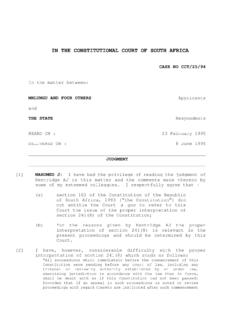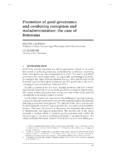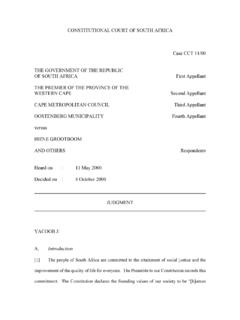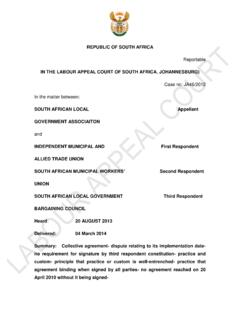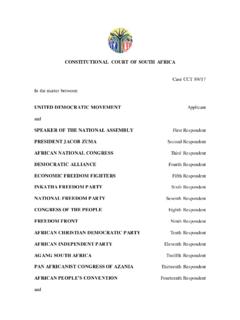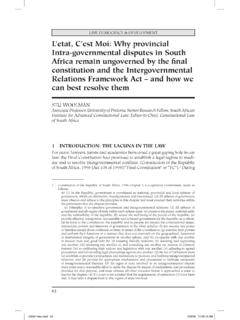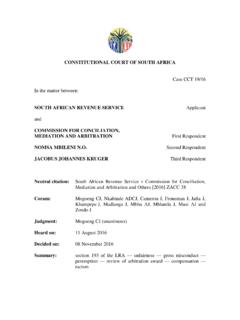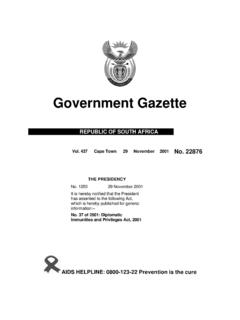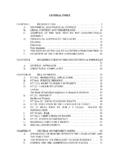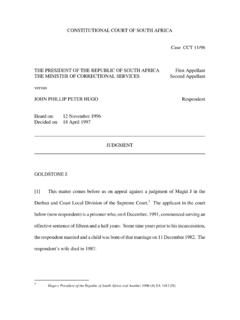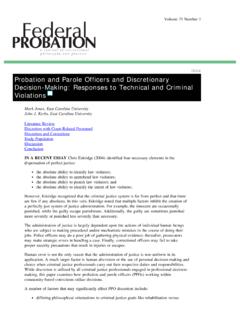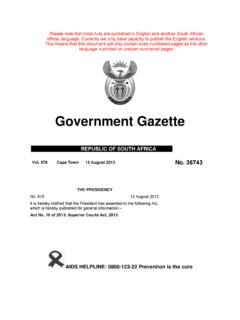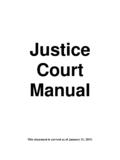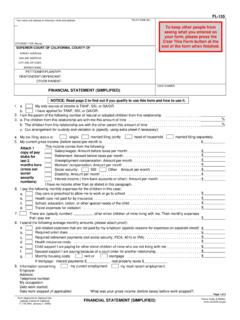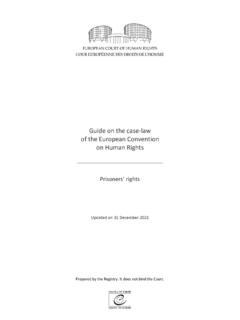Transcription of JUSTICE COLLEGE - SAFLII
1 JUSTICE COLLEGE Prepared by Tux Deosaran and Rochelle Francis-Subbiah, JUSTICE COLLEGE , Pretoria, June 2011 COMPILED BY : T Deosaran, R Francis-Subbiah DATE : JUNE 2011 UPDATED BY : DATE : EDITION : No part of this note may be reproduced or transmitted in any form or by any means without the required permission in writing.
2 JUSTICE COLLEGE , Private Bag X659, Pretoria, 0001, South Africa Tel 012 481 2892 Fax 012 481 2854 The New Magistrates Court Rules The rules of civil procedure in the magistrates court in South Africa have recently undergone significant changes. In the effort to amend the rules so as to enable the regional court to exercise its newly endowed civil jurisdiction in terms of the Jurisdiction of Regional Courts Amendment Act of 2008, the opportunity presented itself to overhaul the entire rules and to also bring greater uniformity with the high court rules. The same set of rules is applicable in both the regional and district divisions of the magistrates civil court inclusive of the regional court s jurisdiction in divorce matters.
3 These amendments are effective from 15 October 2010. Section 171 of the Constitution provides that all courts must function in terms of rules and procedures determined by national legislation. The Magistrates Courts Act 32 of 1944 and the Magistrate Court Rules promulgated thereunder, prescribe the procedure, the time limits, and the forms to be used in the magistrates courts. This guide is intended to provide only a brief overview of the new rules. In the attempt, on the one hand, to provide something more than the bare restatement of the legislation, while on the other hand not wishing to repeat established tomes on the subject of civil procedure, sometimes more is stated and at other times less than what might be considered necessary.
4 Those who have occasion to refer to this guide are therefore cautioned not to use it as a substitute for the well known and reputable works on the subject but to consult those resources for any purposes of reference and research. The opinions expressed in this guide are those of the respective authors only, unless stated otherwise, and do not necessarily reflect the views of JUSTICE COLLEGE . Each of the respective authors bears sole responsibility, and likewise the credit devolves, for their respective contributions as follows: R Francis Subbiah Rules 1 to 15, Rules 33 35, Rule 52, Rule 62, and for the Appendices relating to costs; T Deosaran Rules 16 to 32, Rule 34, Rules 36 to 51, Rules 53 to 61, and Rule 63.
5 _____ 1. Purpose and application of the rules Rule 1 The extent of the changes to the rules is evident in the fact that at least thirty of the old rules have undergone substantial amendments. All of the rules are now gender sensitive and the use of plain language helps in the attempt at being clear, concise and contextualized. Rule 1 is a new rule which appropriately sets out an introductory and contextual purpose and application of the rules. The right of access to the courts with a fair public hearing as set out in section 34 of the Constitution is reflected in rule 1(1) which reads as follows: (1) The purpose of these rules is to promote access to the courts and to ensure that the right to have disputes that can be resolved by the application of law by a fair public hearing before a court is given effect.
6 Its function facilitates process rather than limiting it. Rule 1(2) provides that the rules are to be applied in a manner that facilitates the expeditious handling of disputes with a minimization of costs. This can be interpreted as promoting judicial empowerment in directing parties and controlling the proceedings in the attempt to keep legal costs down and circumvent procedural delays. The third provision of this sub rule also encourages judicial officers to use s54 of the Magistrate Court Act to direct or manage civil matters set down for trial or hearing. The S54 conference, also called a pre trial conference, is not peremptory in the magistrate court as it is in the high court but can be effectively used by a judicial officer to call a conference of litigating parties in chambers at any time of civil proceedings.
7 Case flow management interventions of this nature by judicial officers have radically influenced the number of actions that proceed to trial. On the surface these interventions appear to increase the costs but in actual fact have a beneficial effect of narrowing and limiting the matters in dispute, shortening trials, encouraging more early settlements and thereby have the effect of limiting costs in the long term. Accordingly in Lekota v Editor, Tribute Magazine1 the court explained that the purpose of a pre trial conference is not a full preparation for trial, but a possible cooperation in steps which will limit or prevent avoidable effort and costs.
8 The other sub rules are similar to the old ones 1 1995(2) SA 706 (W) at 709A but are now better constructed. The following prescribed forms must conform fully with the specimen forms contained in Annexure 1: No. 2 simple summons, No. 2A provisional sentence summons, No. 2B combined summons, No. 3 automatic rent interdict summons, No. 5A s57 Request for Judgment and No. 5B s58 Request for Judgment. All other forms may be used with variation. Copies filed of record must comply with the standard A4 white paper printed in black ink.
9 The office of the Registrar has been established in the regional court to oversee all administrative and quasi judicial functions. Hence all reference to clerk of court in the rules also incorporates the registrar . The registrar or clerk of court retains the authority to refuse to issue summons where there is non compliance with the rules. For instance where a summons does not contain all the necessary endorsements as required by the rules, it does not contain the form of the appearance to defend the registrar or clerk may refuse to issue the summons. Although the rule says that noncompliance does not give rise to an exception, the registrar or clerk of court may nevertheless refuse to issue a document that fails to comply with the prescribed forms.
10 However a further challenge confronts the registrar or clerk of court as prescribed form 2B omits essential endorsements referred to in r5(5)(d) which is prescribed by the summons rule 5(5). This has the effect that form 2B as it stands does not comply with the true intention of the rules. It is desirable that the Rules Board effect an urgent amendment to form 2B to reflect the necessary endorsements as prescribed by rule 5(5). 2. Definitions Rule 2 Some definitions such as attorney, company and Act have been deleted. The new rules retain definitions relating to meaning of word in act so assigned, apply , clerk of court , deliver , notice, pending case , plaintiff , defendant , applicant , respondent , party and sheriff.
